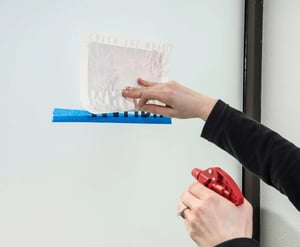- Waterproof Synthetic Paper
-
P.O.P. Displays, Banner Stands & General Signage

- P.O.P. Displays, Banner Stands & General Signage
- View All
- SYNAPSE OM
- ClingZ®
- Trifecta®
- VinylEfx®
- Premium Vinyl
- Classic Vinyl
- PolyEfx®
- ChalkTalk®
- EZ-Color™
-
Window, Wall & Floor Graphics

- Window, Wall & Floor Graphics
- ClingZ®
- Ztac™
- Sign-Ad®
- Hi-Stat®
- Trifecta®
- VinylEfx®
- EZ-Color™
- Overlaminates
- Mounting Films
- Barrier Film
- Wall Graphics®
- ChalkTalk®
- Walk-On Graphics®
- Dye Sublimation
- Glass Finishes
-
Outdoor Graphic Media

- Outdoor Graphic Media
- NextBond™
- Premium Vinyl
- Overlaminates
- Mounting Films
- SYNAPS OM
- SYNAPS XM
- VinylEfx®
- CV300 Series™
- Overlaminates
- Cut Films
- Application Tapes & Premasks
- Carbonless Papers
-
Extruded Films

- Extruded Films
- View All
- ClariCap®
- ClariGuard®
- Security Films
- PETg
- Polycarbonate
- Applications
-
Printer Compatibility

- Printer Compatibility
- View All
- Latex
- Eco-solvent/Solvent
- UV Wide Format
- Offset
- HP Indigo
- Digital Dry Toner/Laser
- Screen
-
Sustainability

- Sustainability
- NextBond™
- Nekoosa Promise™
- Corporate Sustainability & Stewardship
- About Us
- Blog
- Nekoosa Bucks
- Request A Quote
- Resources
- Find A Distributor
- Job Openings
- Contact Us
- Waterproof Synthetic Paper
- P.O.P. Displays, Banner Stands & General Signage
- Window, Wall & Floor Graphics
- Dye Sublimation
- Glass Finishes
- Outdoor Graphic Media
- Overlaminates
- Cut Films
- Application Tapes & Premasks
- Carbonless Papers
- Extruded Films
- Applications
- Printer Compatibility
- Sustainability
- About Us
- Blog
- Nekoosa Bucks
- Request A Quote
- Resources
- Find A Distributor
- Job Openings
- Contact Us
The Do's and Don'ts of Wet Application
Using an application fluid can aid in the application of vinyl films that have an aggressive adhesive system. The application fluid helps float the graphic onto the resulting surface to prevent the vinyl from sticking before you want it to. Nevertheless, for most vinyl installations, you should not apply the graphics wet, especially if you can do a dry application.
In fact, this method is not recommended for all applications, such as when applying air-egress vinyls, reflective or metalized films on unpainted metals, or fleet graphics over rivets, which is explained below in further detail, “When Not to Use Application Fluid.”

Application to an acrylic sign face is one exception to the rule. In fact, it has been said to never apply vinyl to an acrylic sign face dry. Here, an application fluid is required because the vinyl's adhesive wants to grab onto the plastic surface.
The Right Way to do a Wet Application – Step-by-Step:
1. Clean the substrate by wiping it with a rag saturated with solvent, Isopropyl alcohol mixed with water. Then dry the surface with a lint-free paper towel before the solvent dries..webp?width=300&name=WetApplication_SignAd1%20(1).webp)
Removing Milky Residue from Applied Vinyl:
In performing wet applications, some application tape adhesive systems can leave a milky residue on the surface of the applied graphics. In most cases, you can clean off this residue from the vinyl film with something like Rapidtac’s RapidPrep cleaner.
When NOT to use Application Fluid:
While there are some exceptions to this rule, here are some instances when the rule should never be broken:
- Never wet apply fleet graphics over rivets. Application fluid collects underneath rivet heads, creating a residue that later seeps out and causes vinyl to tent and eventually crack. Fluid under trailer-panel seams can also cause edge lifting.
- Never wet apply reflective or metalized films onto unpainted metal.
Application fluid acts as an electrolyte or conductor between the metallization layer of the film and the metal substrate. Electrical particles (ions) flow from the metalized layer to the substrate. During an electrical reaction, one becomes the donor metal, while the other becomes the acceptor metal. As the aluminum in the metallization layer of film loses ions, it corrodes and blackens. - Never perform a wet application when using an air-egress vinyl.
These repositionable vinyl films have micro tunnels embossed in their adhesives. These tunnels will trap application fluid that will most likely result in adhesion failure. Air-egress vinyl films are easy to reposition. There is no reason to use an application fluid when installing these films.
.webp?width=356&name=GMI_Snowflake(3).webp)
.webp?width=337&name=GMI_Snowflake(4).webp)
For detailed information on graphics application, refer to Jim Hingst’s book, Vinyl Sign Techniques. It is available on Amazon.com and at some sign supply distributors.
Search
Categories
- RTape (32)
- Application Tape (15)
- #MeetOurTeam (13)
- Effortless Signage (7)
- Floor Graphics (7)
- SYNAPS (6)
- Synthetic Paper (6)
- Specialty Print Media (5)
- Trifecta (5)
- Walk-On Graphics (5)
- Wall Graphics (5)
- Overlaminate Film (4)
- Wide Format (4)
- Vinyl (3)
- VinylEfx® (3)
- #NekoosaBucks (2)
- ClingZ (2)
- Hi-Stat (2)
- NextBond™ (2)
- Sustainable (2)
- Distribution (1)
- HP Indigo (1)
- Holiday Signage (1)
- Nekoosa Dye Sublimation Transfer Paper (1)
- Nekoosa Glass Finishes (1)
- Pressure Sensitive (1)
- Sign-Ad (1)
- Spray Adhesive (1)
- Textiles (1)
- Window Graphics (1)
- Ztac (1)